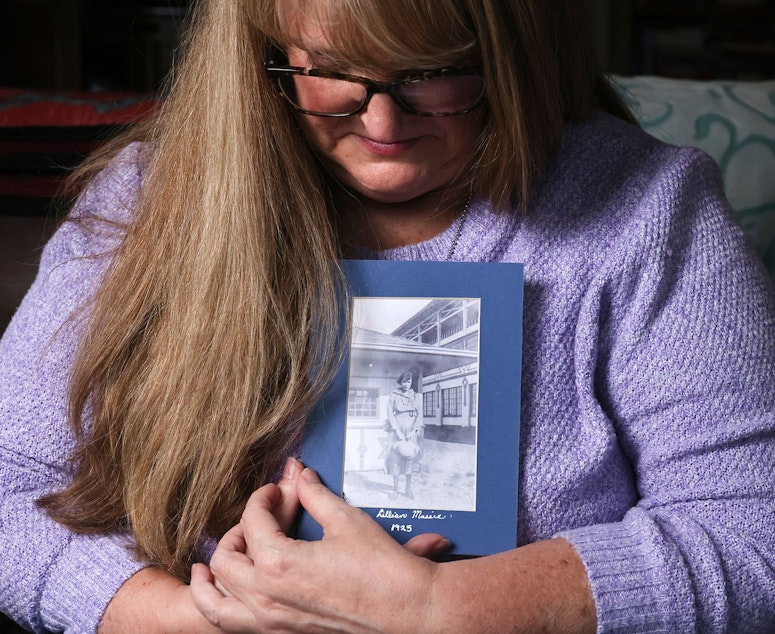This psychiatric hospital shuttered in 1973. But patient descendants and community researchers keep its lore alive

There’s an overgrown cemetery nestled in the farmland of the Cascade foothills of Skagit County. It’s the burial grounds for Northern State Hospital, a long-shuttered state mental institution.
Seattle Times investigative reporter Sydney Brownstone recently spent time out in that cemetery.
She wrote about the Northern State Hospital in her new story, "The lost patients of WA’s abandoned psychiatric hospital."
She sat down with Soundside host Libby Denkmann to discuss the history of the psychiatric hospital, why it shut down, and what we can learn about modern mental health care from the history of one institution.
Brownstone said she came to this story following a chance encounter with John Horne, a volunteer who devotes much of his free time to identifying the unmarked graves in the hospital’s cemetery.
“He tells me that he estimates there are more than 1,600 people buried in this area, and we don't know who they were,” Brownstone said.
Sponsored
She also learned that Northern State was started as a farm extension to feed Western State Hospital patients. Officials brought over patients from Western State, which was overcrowded at the time, to help run the farm.
Northern State began admitting patients in 1914, Brownstone said.
“All these counties and cities were desperate to offload the costs of care for vulnerable people, and sent to institutions, all sorts of people who really shouldn't have been there. So people with dementia, and epilepsy, and alcoholism,” she said.
Officials operating the hospital had envisioned it as an occupational therapy facility: “People would come there, they would find value in working in this really therapeutic and beautiful environment. And then they would return to their communities as productive members of society,” Brownstone said.
But that utopian vision clashed with the hard realities facing the institution. Patients weren’t getting better, costs of operating the facility swelled, and doctors resorted to treatment plans considered unconscionable today, like intentionally infecting patients with malaria, inducing insulin comas, and hydrotherapy.
Sponsored
“The deliberate malarial infections were given to patients to try and induce a fever that would wipe out their illness,” Brownstone explained. “And then there was this whole period of time where people thought mental illness had bacterial origins, so they were just removing people's thyroids and tonsils right and left because they thought an infected thyroid was the problem.”
She also pointed to evidence that Northern State sterilized approximately 100 patients between 1935 and 1940, and performed a number of lobotomies in 1949 and 1950.
But conventions surrounding mental health care began changing in the 1950s and 1960s, Brownstone said.
“Psychiatry went through this period of professionalization or medicalization. So rather than having attendants treat patients in a really custodial way, you start having trained nurses and doctors really treating patients. And also…you get sedatives and anti-psychotics, which totally changes the game.”
Northern State underwent its own reckoning during that time, too.
Sponsored
“At Northern State, there’s a different conversation around human rights and autonomy. There's this idea that people should not be hidden away and rotting in institutions – they should return them to their communities, and that's the only way they can heal.”
By the early 1960s, Northern State was considered the most progressive of the state’s three psychiatric hospitals.
“It had something called an open door policy where patients had freedom of movement on the campus. And that faced a huge backlash because of stigma, because people were afraid of patients escaping or having illegitimate children with one another."
That progressive philosophy ultimately cost Northern State, which shuttered in 1973 due to high expenses related to the release – and often readmission – of patients.
“...the state and the federal government never fully funded community care after that,” Brownstone said. “In a lot of cases, there was nowhere for people with serious mental illnesses to go.”
Sponsored
But the hospital’s legacy and lore live on.
For his part, John Horne, the cemetery volunteer, is dedicated to helping the loved ones of past Northern State patients piece together their relatives’ untold or forgotten stories using records and details found on the grave markers he’s uncovered.
Along the way, Horne connected with Carrie Davidson, whose great-grandmother, Lillian Massie, was held at Northern State from the age of 24 up until her death nine years later. Massie was institutionalized by her husband after experiencing psychiatric symptoms related to a syphilis infection.
“When I first met [Davidson], she had tracked down all of these census records – these birth and death certificates – this court case from 100 years ago, and she had even hired a medium to try and locate Lillian's grave,” Brownstone said. “But she couldn't find the place where Lillian was buried.”
Davidson hit another wall after trying to get into the State Archives for more information.
Sponsored
“At that point, the State Archives restricted records that had patient information in them, and they would only transcribe some information for Carrie,” Brownstone added.
But after asking questions and digging around herself, Brownstone said the state changed its tune, allowing the records of patients dead 50 or more years to be unsealed.
“I think for Carrie, there's a difference between knowing facts about her great-grandmother's life and then being able to see in-person artifacts that were there when she was there,” Brownstone said.
You can read Brownstone's full report on Northern State Hospital here. Listen to Soundside's full interview with Brownstone by clicking the play button at the top of this story.






